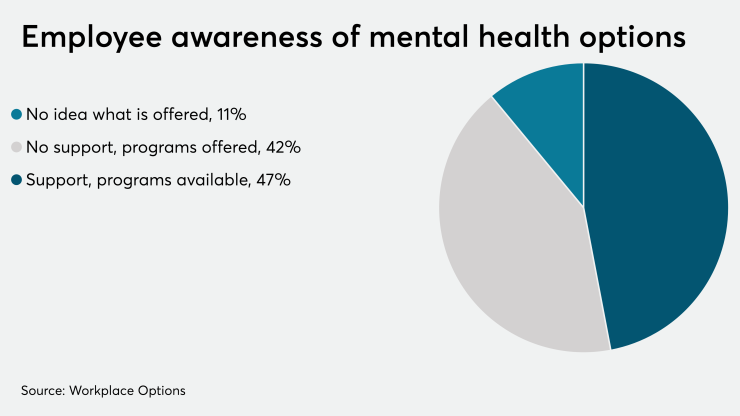Employers are making employee safety a greater priority as offices and businesses begin to reopen. These safety steps include conducting testing, providing personal protective equipment, redesigning office spaces and changing staffing models.
While protecting employee’s physical health is vital, it’s equally important that organizations take steps to support the mental health of their employees as well, many of whom face new and challenging concerns, stressors and demands brought on by a return to the workplace in the midst of a pandemic.
Since mid-March, when the CDC categorized COVID-19 as a pandemic, the U.S. has been experiencing a surge in people showing signs of serious mental health distress. Recent data from the U.S. Census Bureau shows a significant increase in the number of Americans struggling with depression and anxiety. As a result, employers must acknowledge that their employees are experiencing a variety of reactions to the idea of returning to the workplace.
Whereas some are chomping at the bit to get back, others are reluctant to return and are worried about their risk of exposure. Parents and caregivers may also face challenges returning without their usual support systems and care options – and employees who are older, at high risk of infection (or who live with someone who is) may not feel safe returning at all.
Given these significant stressors, every return-to-work plan should include a focus on employee mental health. By creating an emotional fitness checklist, organizational leadership can have a positive impact on the mental health and wellbeing of their employees as they transition back into the workplace. While every checklist should be tailored to the unique needs of the employer, the following tactics apply broadly and can serve as a starting point for most organizations.
Support employees now
Employers and leaders can set a tone that emphasizes concern for employee wellbeing by offering compassion, honesty and openness. Check in with employees and actively listen so they feel heard. Communicate consistently to reduce employees’ uncertainty and build emotional support.
Take an individualized approach
Now is the time to think beyond a one-size-fits-all approach to how employees work. Provide autonomy to managers and supervisors to help employees develop individualized plans. Employees returning to the workplace may need new approaches to routines that they’ve lost. Supervisors can play a role in helping employees structure their day.
Provide training
Managers play a key role in supporting mental health and well-being and are the front-line of recognizing employee mental health struggles. Provide managers with training and resources that they can use to help their workers. For example, improve mental health literacy with psychological first aid or training on how to talk about mental health.
Be flexible
Employers can create a favorable environment by encouraging employee control over decisions about aspects of where and when they work. For example, some employees may be able to continue working remotely without any impact on their productivity. Others may appreciate being allowed to set their own working hours to avoid comminuting during peak public transportation times.
Involve employees
Talk with employees about what might change and what they need. Employees who are informed and participate in decisions about their own workspace feel more comfortable in the workplace. This engagement helps them adapt to changes they can’t control, such physical distancing requirements.
Set an example
Employees look to leaders during a crisis. Leaders can be role models and help set examples. Acknowledge that returning to the office isn’t a return to the way people previously worked. Organizational policies and practices may need to adapt and change with the uncertainty of the pandemic’s effects. Prepare to be flexible, consistent in communications and a role model for showing support and encouraging individual control and decision-making.
Engage your EAP
There is no better time than now to increase engagement with your employee assistance program. EAPs have evolved and innovated – and are still the best end-to-end employer-sponsored mental health solution.
1. Frequently promote the availability of EAP resources for employees and their families through multiple communication channels, such as emails, newsletters, posters, company intranet, digital signs and team meetings.
2. Make sure you know everything the program offers. Learn more about the modalities and tools your provider uses to connect employees to the program, such as text therapy, video counseling, navigation, digital behavioral health and around-the-clock access to licensed clinicians for in-the-moment support.
3. Ask your EAP about online self-care tools and resources focused on topics such as resilience, mindfulness, meditation and psychological first aid.
4. Ask your EAP vendor to provide data regarding use of the program, as well as the primary concerns and focus areas of your employees. This allows you to understand what employees are experiencing and to proactively support managers in working with their teams.
5. Set a meeting with the EAP to strategize on new program offerings, trainings and other tools to meet the needs of your employees. Collaborate with the provider to discover new and innovative ways to connect employees with support.
As difficult as it may be, the plan for recovery will require a sustained and focused effort. While employers already understand that employees are their most valuable resource, taking proactive steps to support both their mental and physical health as they return to the workplace will help them stay happy, healthy and productive.






